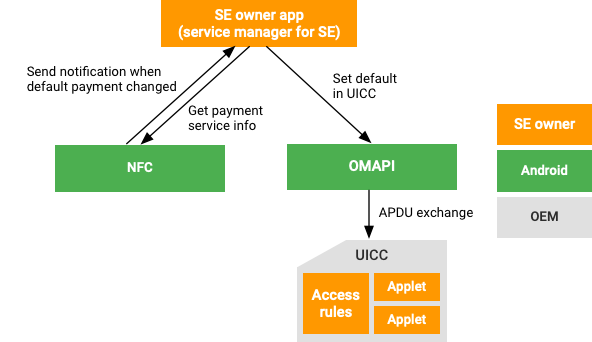Android, ana bilgisayar dışı kart emülasyonu için güvenli öğeyle NFC kart emülasyonunu destekler. (Daha fazla bilgi için Ana makineye dayalı kart emülasyonuna genel bakış başlıklı makaleyi inceleyin.) Ancak Android platformunda, Dokundur ve öde ayarında belirtilen tercih edilen ödeme hizmeti, güvenli öğedeki uygulamayla her zaman senkronize edilmez. Bu, güvenli öğede tercih edilen ödeme hizmeti yerine tercih edilmeyen bir ödeme hizmetinin kullanılabileceği anlamına gelir.
Android 11'deki off-host ödeme senkronizasyonu özelliği, Dokundur ve öde'deki ödeme yapılandırmasını, temassız ön uçtaki (CLF) yönlendirme yapılandırmasını ve güvenli öğedeki uygulama tarafından seçilen durumu senkronize etmenize olanak tanıyan bir mekanizma sağlar.
Aşağıdaki şemada, ana makine dışında ödeme senkronizasyonu özelliğinin tasarım mimarisi gösterilmektedir.

Uygulama
Cihazın, ana makine dışı ödeme senkronizasyonu özelliğini uygulamak için NCI 2.0 standardını destekleyen bir NFC denetleyicisine sahip olması ve Android Açık Kaynak Projesi NFC ile Açık Mobil Uygulama Programlama Arayüzü (OMAPI) çerçevelerini kullanması gerekir.
Framework API'leri
Ana makine dışı ödeme senkronizasyonunu uygulamak için Android Açık Kaynak Projesi'nde bulunan aşağıdaki çerçeve API'lerini kullanın:
getAidsForPreferredPaymentService(): Tercih edilen ödeme hizmeti için kayıtlı AID'leri (Uygulama Tanımlayıcıları) alır.getRouteDestinationForPreferredPaymentService(): Tercih edilen ödeme hizmetinin rota hedefini alır.getDescriptionForPreferredPaymentService(): Tercih edilen ödeme hizmetinin kullanıcı tarafından görülebilen açıklamasını döndürür.android.permission.NFC_PREFERRED_PAYMENT_INFO(izin): Uygulamaların NFC ile tercih edilen ödeme hizmeti bilgilerini almasına olanak tanır.android.nfc.action.PREFERRED_PAYMENT_CHANGED(yayın işlemi): Tercih edilen ödeme hizmeti değiştiyse bildirim gönderir.
Doğrulama
Cihaz dışı ödeme senkronizasyonu özelliğini uygulamanızı doğrulamak için ilgili güvenli öğelerle birlikte güvenli öğe uygulamalarını yükleyin ve ardından farklı koşullarda NFC okuyucudan uygun yanıtlar alıp almadığınızı kontrol edin.

